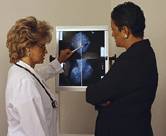
TUESDAY, Dec. 3, 2013 (HealthDay News) — Breast cancer risk in women may be tied to the rate at which their breast-tissue density changes as they age, a new study suggests.
Researchers examined 282 breast cancer patients and 317 women without the disease who underwent both mammography and an automated breast-density test.
Breast cancer patients under age 50 tended to have greater breast density than healthy women under age 50, the researchers said Tuesday at the annual meeting of the Radiological Society of North America, in Chicago.
Overall, the healthy women also showed a significant, steady decline in their breast density with age. There was considerably more variation in the amount of density loss among the breast cancer patients.
“The results are interesting, because there would appear to be some form of different biological density mechanism for normal breasts compared to breasts with cancer, and this appears to be most obvious for younger women,” study senior author Nicholas Perry, director of the London Breast Institute in the United Kingdom, said in a society news release.
“Women under age 50 are most at risk from density-associated breast cancer,” Perry said. “Breast cancer in younger women is frequently of a more aggressive type, with larger tumors and a higher risk of recurrence.”
Breast density, as determined by mammography, is already known to be a strong and independent risk factor for breast cancer. The American Cancer Society considers women with extremely dense breasts to be at moderately increased risk of cancer and recommends they talk with their doctors about adding MRI screening to their yearly mammograms.
“[The findings are] not likely to diminish the current American Cancer Society guidelines in any way,” Perry said. “But it might add a new facet regarding the possibility of an early mammogram to establish an obvious risk factor (breast density), which may then lead to enhanced screening for those women with the densest breasts.”
For example, some women might undergo a modified exposure exam at age 35 to establish breast-density levels. Those with denser breast tissue would follow up with mammography and additional imaging, such as MRI or ultrasound, for earlier cancer detection and treatment.
Two experts not connected to the study agreed that the density of a woman’s breast is a key factor in her risk for breast cancer.
“This new study further [shows] the importance for women to be aware of their breast density,” said Dr. Loretta Lawrence, chief of breast imaging services at the North Shore-LIJ Health System in Great Neck, N.Y. “Those with dense breasts should be evaluated in conjunction with their other risk factors for breast cancer, and possibly be referred for additional secondary breast cancer screening for enhanced breast cancer detection.”
Dr. Stephanie Bernik, chief of surgical oncology at Lenox Hill Hospital in New York City, added one caveat, however.
“More evidence is pointing to the importance of breast density when considering a person’s risk for breast cancer,” she said. “However, one must be careful not to assume that screening at an earlier age is automatically better.”
“[Breast] MRIs are a very expensive test with a high false-positive. It is also an invasive and time-consuming test,” she said. “Additional testing for young women with dense breast tissue needs to be tested before we can say with certainty that the benefits outweigh the risks.”
Findings presented at medical meetings typically are considered preliminary until published in a peer-reviewed journal.
More information
The American Cancer Society outlines breast cancer risk factors.
Copyright © 2025 HealthDay. All rights reserved.

